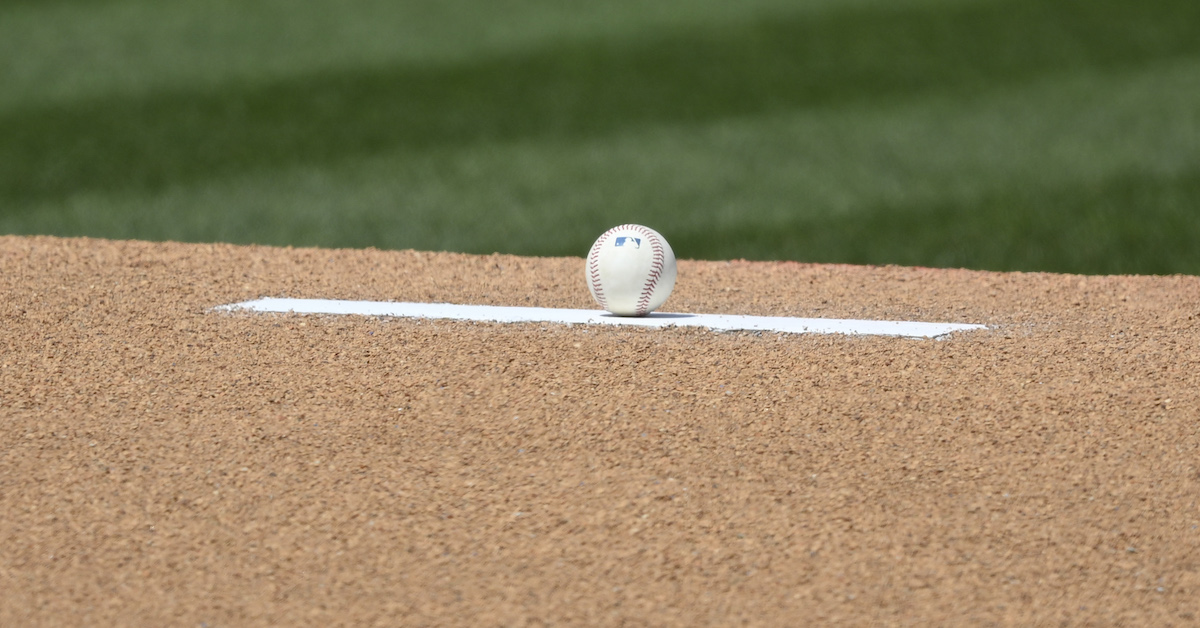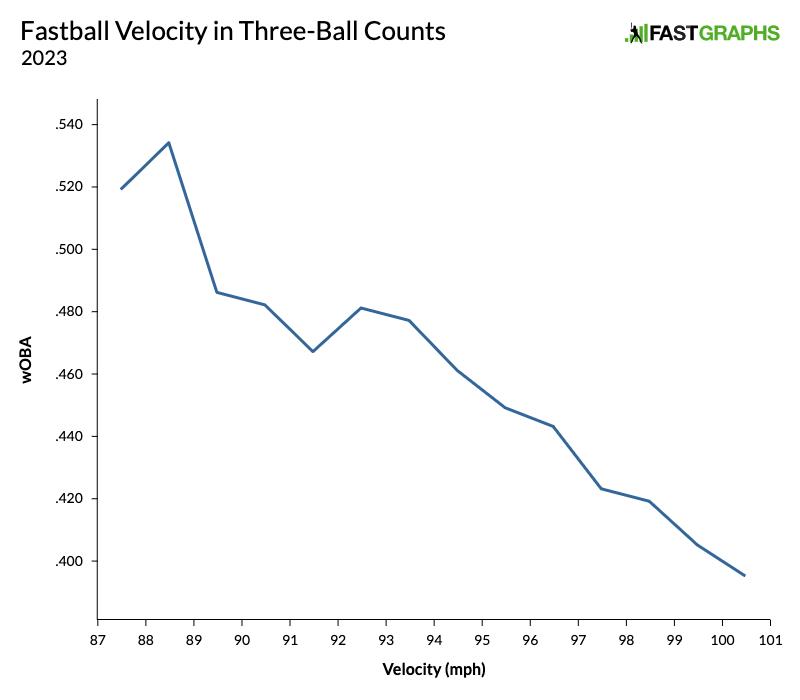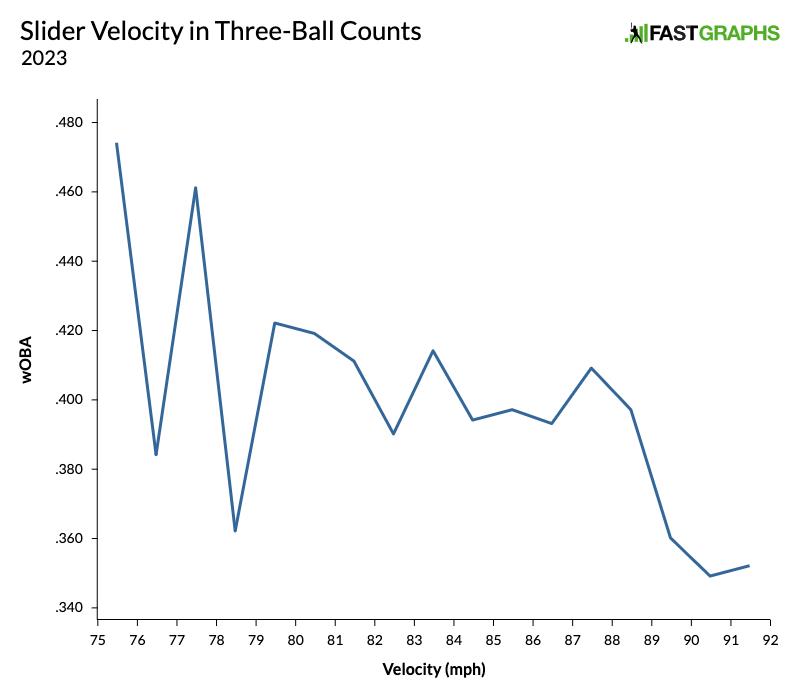
© David Richard-USA TODAY Sports
Well, Mike Rizzo wasn’t joking. At the Washington Nationals’ spring training facility, behind each of the 11 home plates in the bullpen, there are signs posted, and they’re not printed on paper. Somebody in the organization shelled out to have “I don’t care how fast you throw ball four” printed on canvas, in team colors, with a border all around and a logo at the bottom. The grommets at each corner, which allow them to be zip-tied tightly to the fence, probably cost extra. No National will throw a bullpen without seeing those signs for the next month. Whenever the team decides to remove them, somebody is going to have a rough a time cutting through all that thick plastic. It’ll take some doing.
Rizzo road tested the line at the team’s annual hot stove event in January, and it brought down the house, earning sustained laughter and an applause break. In the absolute most literal sense, he’s right. If a pitch ends up as ball four, who cares how hard it was thrown? You might as well huck it up there underhanded like a cricket bowler. But that’s not really how baseball works. The pitcher doesn’t know beforehand whether the batter is going to swing, so let’s take Rizzo a shade less literally and look at how fastballs perform when they’re thrown in three-ball counts. The graph below shows four-seamers and sinkers, bucketed in one mile per hour increments. I went back and checked the numbers a second time because the line is so straight that the graph looks like it was airbrushed:

Last season, 615 four-seamers and sinkers were thrown between 99 and 100 mph in three-ball counts, and they had a combined wOBA of .405. That’s not great for the pitcher — it basically turns every hitter into Freddie Freeman, who finished the 2023 season with a .411 wOBA — but that’s to be expected. These are fastballs in a fastball count, when the pitcher feels like they have to throw it over the plate and the batter is ready to attack their pitch.
Besides, that’s a pretty desirable outcome compared to the 665 four-seamers and sinkers thrown between 88 and 89 mph. Those fastballs had a combined wOBA of .534. No hitter posted an equivalent wOBA during the 2023 season. In fact, the only player this century who produced in that range was 2001 Barry Bonds, who had a .537 wOBA (!) and hit an all-time record 73 home runs. I rarely feel the need to curse when I’m writing, but allow me to reiterate: If you throw an 88-mph fastball in a three-ball count, you’re effectively turning the hitter into 2001, 73-homer, ISO-that-starts-with-a-five, muscles-that-Mother-Nature-never-even-dreamed-of-rippling-out-of-his-eyeballs, Barry Bleeping Bonds. He may be one of the best hitters in baseball right now, but I’d rather face this guy any day:
The graph above tells us that each 1-mph increase in velocity effectively knocks just over eight points off the batter’s wOBA. As you’d expect, curveballs and offspeed pitches aren’t correlated with velocity in the same way, but sliders do show a fairly strong connection:

This is why models like Stuff+ and PitchingBot, not to mention big league teams, value velocity so highly. It may not matter how hard you throw ball four, but it definitely matters how hard you throw your fastball when ball four is a possibility.
At this point, I want to stop and make it clear that the goal of this article is not to dunk on Mike Rizzo. There are many reasons for this. First, that’s not a nice thing to do. Second, Rizzo is the only executive to bring a World Series trophy to my hometown in my lifetime. Third, I don’t want to burn any bridges in Washington — I’m still holding out hope that the Nationals will start using the fight song I wrote for them as their seventh-inning stretch music. Fourth, it’s not as if Rizzo’s a dope. I’m sure he knows everything I just showed you. Take a look at the video clips the team posted on social media:
You can see the signs, and in a smack-you-upside-the-head stroke of irony, right next to them you can see the portable Trackman units that literally measure the velocity of every pitch (along with its spin and movement profiles). Next to the Trackman units, you can see video cameras; behind the pitchers, you can see Edgertronic cameras that capture high-speed images of the way the ball comes out of the hand. The bullpen is tripod city, just like the bullpen of every other club. What I’m trying to say is that the Nationals obviously do care about velocity and a whole host of other factors that they absolutely should care about.
That’s not to say they’re a leader in the field. For years now, the Nationals have been drafting, signing, and trading for pitchers who can light up a radar gun but lack the fastball shape to actually get batters out. It’s inarguable that Washington is behind the rest of the league in terms of scouting, analytics, and player development. Rizzo has more or less admitted as much. He made drastic changes to the front office following both the 2021 and 2023 seasons, telling reporters during both shakeups that harnessing new technology was the team’s new priority.
Still, failing to implement an effective pitching assessment and development plan isn’t necessarily the same thing as not understanding the state of pitching. I can’t imagine that Rizzo actually thinks missing the strike zone was the reason that the Nationals had the seventh-highest walk rate in baseball last season. It definitely wasn’t. In fact, their 49% zone rate was 16th in baseball, exactly the same as the league average! They hit the strike zone at an extremely normal rate, if such a thing is possible. The problem was a lot simpler and a lot more serious: Their stuff wasn’t up to snuff. It had the horrible combination of being hittable but not chaseable. Last year, there wasn’t a single team that made the playoffs and finished in the bottom third of the league in either chase rate or whiff rate. The Nationals finished in the bottom four (not the bottom fourth, the bottom four) in both.
It’s true that in the first pitch of an at-bat, Washington pitchers hit the strike zone just 52.5% of the time, which ranked 24th in baseball. However, that’s not necessarily the end of the world. The Nats were just below the Diamondbacks and just above the Brewers and Astros. That’s not terrible company. The problem is that when the Nationals didn’t hit the zone, nothing good happened. They had the fourth-worst chase rate in baseball, at 26.8%. As a result, they had a 60% first-pitch strike rate and 28.1% of their pitches were thrown while behind in the count, both of which ranked 27th in baseball.
That was the not chaseable part, and this is the hittable part. The Nationals allowed the highest barrel rate, the third-highest contact rate and hard-hit rate, and the fifth-highest exit velocity in baseball. As you might have read in excellent articles by either Stephanie Apstein or the duo of Zach Crizer and Hannah Keyser (aka Creyser), one of the trends that swept the sport in 2023 was simply trusting your stuff; throwing the ball right over the plate and daring the batter to hit it. That blueprint certainly worked for the Nationals back when Max Scherzer was challenging batters with 97 mph fastballs down the middle, but these days they just don’t have the stuff to miss bats or induce weak contact. As a result, nothing good happened when the Nationals ventured into the zone either. Their .350 wOBA on pitches in the strike zone was tied with St. Louis for the second-highest in baseball. In 2023, the Nationals threw 1,932 pitches in gameday zone 5. When you divide the strike zone into thirds, that’s the square that’s right in the middle. Baseball Savant refers to pitches that end up there as meatballs, and the Nationals served them up:

That total of 1,932 was the second-highest in baseball, behind the Cardinals and ahead of the A’s, Rockies, and Angels. That’s not exactly the company one hopes for. Worse, the Nationals led all of baseball with 71 home runs allowed in zone 5. The team in second place had just 62, and most teams were under 45. More importantly, if you thought that I wasn’t going to make a supercut of all 71 down-the-pipe dongs, then buddy, you don’t know me at all:
While falling behind too much may have led the Nationals to throw more hittable pitches in the zone, there’s just no way you can come away thinking that location was the main culprit. The better your stuff, the less your location matters, but neither were working for the Nationals in 2023. PitchingBot ranked Washington’s command 21st in the league, and Location+ had it at 21st. Those are both bad. Much worse was that PitchingBot ranked their stuff 28th, and Stuff+ had it at 29th. And while the team has two or three pitching prospects to dream on, there isn’t much help on the way. According to Baseball America, Washington’s minor league system ranked 28th by Stuff+ in 2023. And even those couple of prospects aren’t free from the team’s endemic flaws. As our prospect team recently noted, Cade Cavalli has a fastball that plays far below its velocity, and Jarlin Susana “had a mediocre strikeout performance in 2023 even though his stuff is really nasty-looking.”
Rather than leave you on such a downer note, I should mention that Rizzo’s overall point is not without merit. Here’s the full quote that he gave back in January. Seated onstage in a shiny, red armchair between manager Dave Martinez and newly appointed pitching coordinator Sean Doolittle, Rizzo told the fans:
The staff has to do a better job of throwing strike one. To me, it’s the most important pitch in the game. We’re going to put up a sign in spring training — I told Dave we’re going to put up a sign in spring training: “I don’t care how fast you throw ball four.” Doesn’t matter to me. I don’t care how hard you throw ball four. The margins between winning and losing are too thin. You’ve got to give them 27 outs and 27 outs only. You can’t make mistakes on the bases…
Rizzo’s got a young team, and he doesn’t want them making boneheaded mistakes or getting in the habit of walking the bases loaded. “In this league, you have to throw strikes,” he told reporters more recently. “I didn’t want to be a smarta** and put that up, but I think with one of the youngest teams in the league like we have and a young pitching staff, I wanted them to know that is important to the guy making the decisions on who’s making the team.” The Nationals are deep into rebuild mode, and if ever there’s a time for their young pitchers to trust their stuff and find out whether or not it plays, this is it. Still, a couple more ticks of velocity might really help, even on ball four.
Source
https://blogs.fangraphs.com/mike-rizzo-absolutely-cares-how-fast-you-throw-ball-four/
 Backyard GrillingWeekend WarriorsAdvice from DadBeard GroomingTV Shows for Guys4x4 Off-Road CarsMens FashionSports NewsAncient Archeology World NewsPrivacy PolicyTerms And Conditions
Backyard GrillingWeekend WarriorsAdvice from DadBeard GroomingTV Shows for Guys4x4 Off-Road CarsMens FashionSports NewsAncient Archeology World NewsPrivacy PolicyTerms And Conditions
